A hot August sun punched through rain clouds as my wife Donna and I exited our truck at the Fannie Stebbins Wildlife Refuge, in Longmeadow, Massachusetts, now part of the Silvio O. Conte National Wildlife Refuge.
Great egrets stalked the edge of an ancient river channel. A woman, who had been photographing them through a lens longer than her arm, hurried by, announcing that she was again late for work. Presently, a tall young man walked over and greeted us.
He was Dr. Christian Marks, a floodplain ecologist with The Nature Conservancy’s Connecticut River Program.
Donna and I were there to learn about the role of floodplains in sustaining fish and wildlife and how the Conservancy and its partners are recovering floodplains along this 410-mile river draining Vermont, New Hampshire, Massachusetts and Connecticut.
Since his childhood on a New Brunswick farm Marks has been fascinated with trees. He studied them in his PhD and post-doc work. That perspective and knowledge proved invaluable to the recovery effort, particularly for finding, propagating and planting disease-resistant American elms.
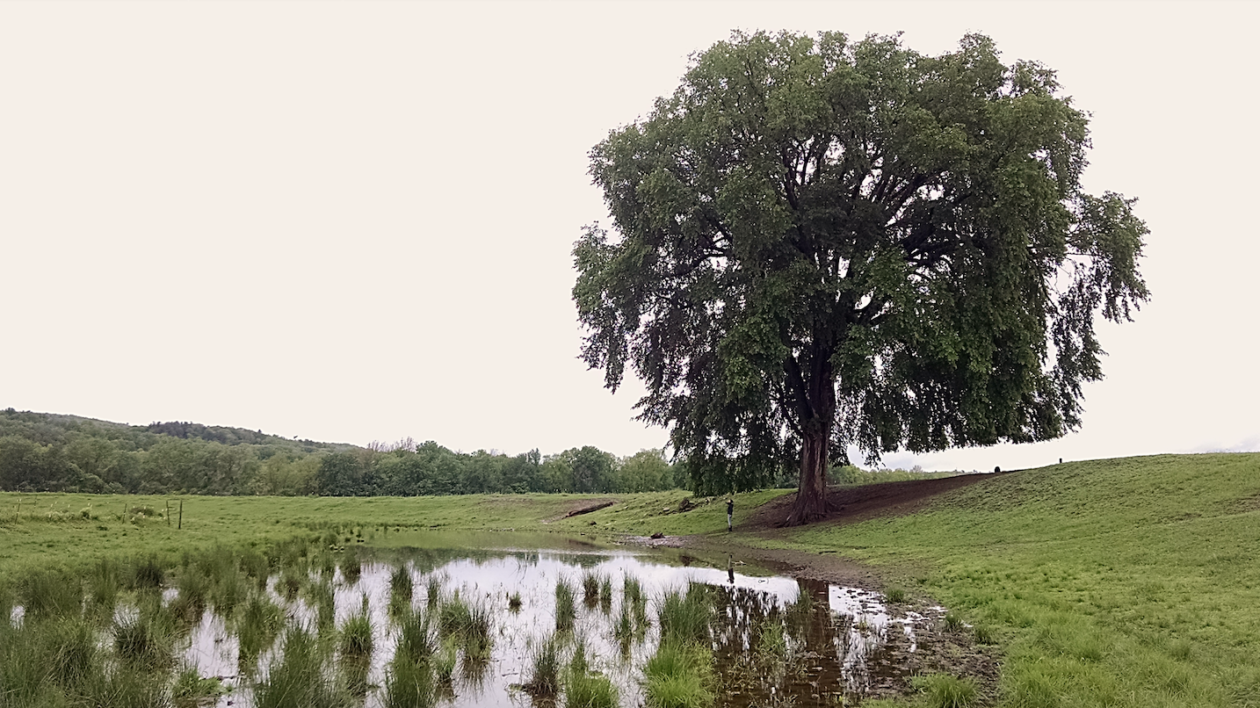
In 2017 Suki Casanave wrote about the partners’ elm work for Cool Green Science. My assignment was to report progress since then—not just on elm recovery but recovery of the entire floodplain ecosystem.
I asked Marks what healthy floodplains do for wildlife.
“Some birds and mammals see the forest in terms of structure,” he replied. “Certain warblers, for example, like the tops of trees and don’t care what species as long as they’re tall. So it’s important to maintain the canopy. Wildlife species that depend on flowers and seeds need something all year. Migratory birds need something from the time they get here until the time they leave. Floodplain trees and shrubs produce flowers or seeds in small windows, and each does something different.”
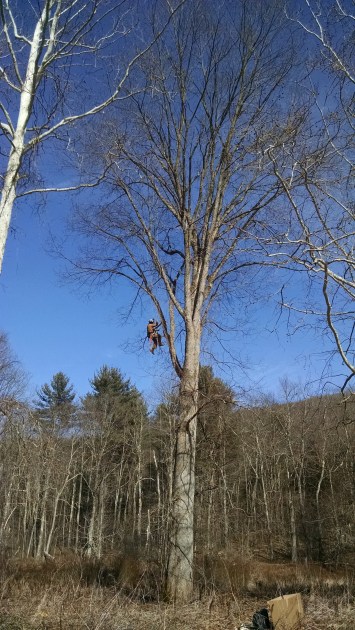
Spring can be tough on granivore rodents and birds, Marks went on to explain. Most berries have been eaten. Uplands green up, but with leaves useless to granivores.
Floodplain trees are the granivores’ salvation. They flower in late winter and produce seeds in spring. That’s part of the reason migratory birds follow the river north
These trees are adapted to spring freshets. If their seeds were dispersed in fall, they’d get buried by sediments and rot. When high water recedes in spring it leaves a perfect seedbed of fresh sediments.
Elms, highest in the floodplain, produce seeds first because that’s where the water first recedes, then silver maples, then cottonwoods, then willows—each following the elevation where it grows in the floodplain and each feeding different granivore birds as they arrive.
This fall the Conservancy will have attained its goal of restoring 223 acres of floodplain habitat at Fannie Stebbins. This acreage, along with the refuge’s existing floodplain forest, will constitute the largest connected expanse of natural floodplain habitats in the four Connecticut River states.
The Search for Disease-Resistant Elms
In 1928 an Asian fungus showed up in North America, but because it was first isolated by a phytopathologist from the Netherlands it was dubbed “Dutch Elm Disease.”
Previously American elms had been the oldest and most abundant floodplain species, filtering out sediments, reducing flood damage, providing food, cover and nesting habitat for terrestrial wildlife and shade and bank stability for fish.
“That’s a wild elm,” Marks declared, pointing to a sickly tree with a trunk about eight inches in diameter. “This is typically how big they get before they die. I look for ones that are at least three feet in diameter because they might have some resistance. We test those, and we’ve found a few that do have high tolerance. We plant them back in elm habitat so they can fulfill this niche of late-successional, canopy-dominant floodplain trees.”
Marks hunts for big elms anywhere and everywhere. The alien and native bark beetles that spread the fungus can’t fly far, so he’s not interested in big elms isolated in, say, city parks. The best candidates are survivors surrounded by dead elms.
“We have seven varieties of resistant American elm, and the Forest Service is propagating a few more that we’ll plant soon,” Marks continued. “For genetic diversity we want between 20 and 30. Otherwise we’ll have problems with inbreeding. Resistant elms are extremely rare; that’s why we have to do this work. If there were several in every forest, Mother Nature would take care of the disease with natural selection.”
In field trials, elm seedlings presumed to have a degree of resistance are injected with the fungus. Something like a third survive, and most of these show symptoms. If one remains in perfect shape, that’s a big win.
Crossing American elms with naturally resistant Asian elms is impossible. American chestnut trees, for example, can be crossed with blight-resistant Chinese chestnuts, then backcrossed until you get resistant American chestnuts that are nearly pure. But American elm has four copies of every chromosome while all other elms have two.
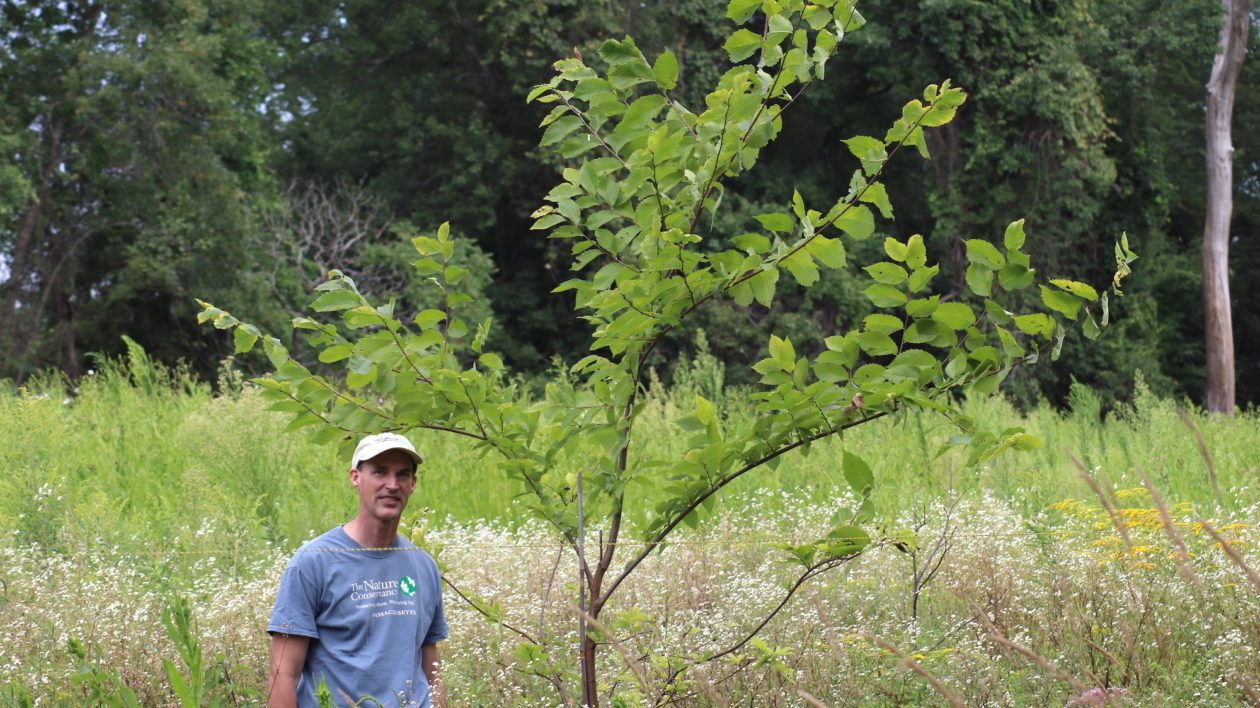
Resilience in an Era of Invasive Pests
Elm recovery is only one component of a far larger effort at Fannie Stebbins. The Conservancy has planted 19 other species of floodplain trees and shrubs, totaling over 8,000 individuals.
Swamp white oak, for example, is near its northern range limit at the refuge. But global warming will be pushing it north. The species does well in old fields, so Marks and his team have planted lots of it in the seven abandoned hayfields. They’ve also planted shrubs that produce berries important to birds. These include dogwoods, arrowwoods, chokecherry, elderberry, winterberry and buttonbush.
We paused beside a wet swale rife with buttonbush so Donna could photograph basking painted turtles, carapaces green with duckweed. Buttonbush is flood tolerant but can’t take shade. Elm is one of the few species that can survive the combination.
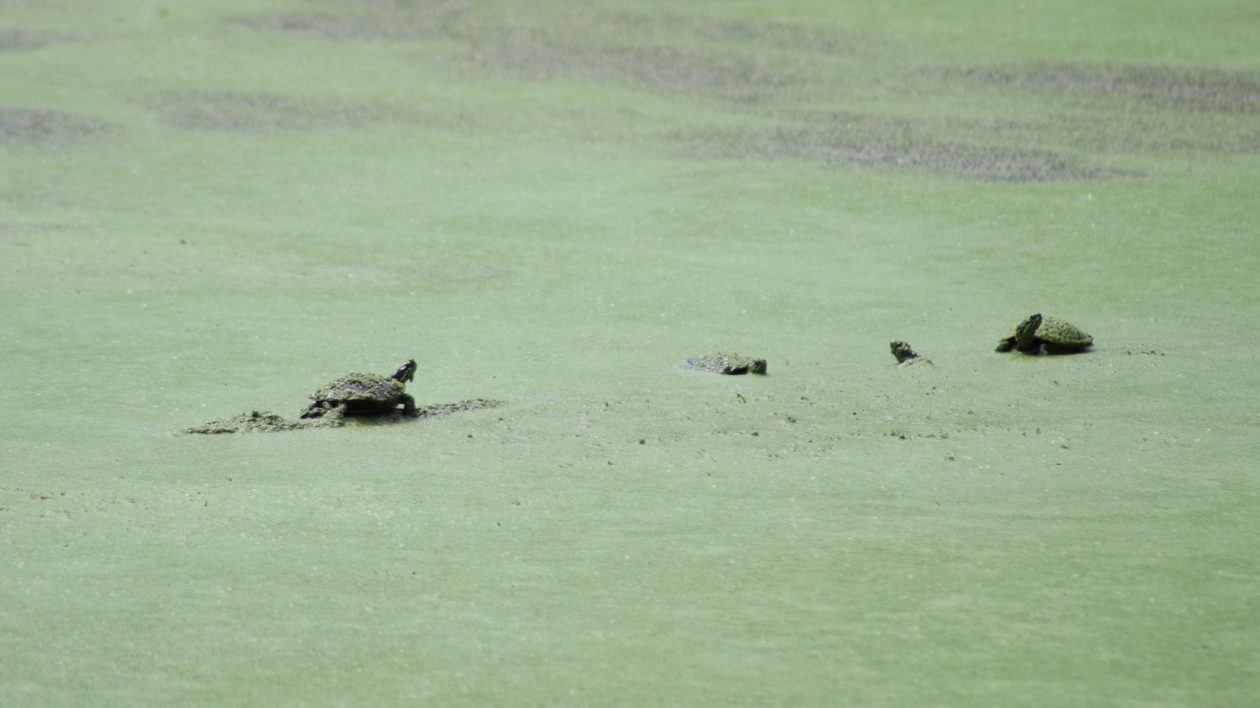
One species the Conservancy hasn’t planted is green ash, but there’s hope for recovery. This dominant floodplain tree is being devastated by emerald ash borers. Marks knew they were coming up the valley, so he and a UMass grad student went looking for them.
When they found them the Massachusetts Department of Conservation and Recreation released biological controls consisting of three parasitoid wasp species that coevolved with the borer in Asia. Two lay their eggs in borer larvae, one in the eggs. The wasp most recently released has a longer ovipositor, so it can reach larvae in older trees with thicker bark.
One of the obstacles wildland managers strive to overcome is public opposition to biological controls. It issues from ancient blunders such as the unleashing of mongooses and even house cats for presumed rodent control. These disasters were created, in Marks’ words, “not by scientists but rogue, random people who had absolutely no understanding of biology.”
Today potential biological-control species undergo rigorous “starvation tests” under strict quarantine. They pass only if they die before eating all related non-target species.
Marks stopped beside a green-ash stand. “This is where we’re studying the effects of the wasps,” he said. “We’ll monitor it for a decade. Then we’ll compare it to a stand in Agawam, Massachusetts that doesn’t have biological controls.
“With ash and elm going, we’re losing two of the floodplain dominants. You lose a species in the floodplain forests of Mississippi, and there are another 20 to take its place. If something happens to the maples here, we’re all out. You need resilience, especially in northern climates where you don’t have many species. That makes our elm work all the more important.”
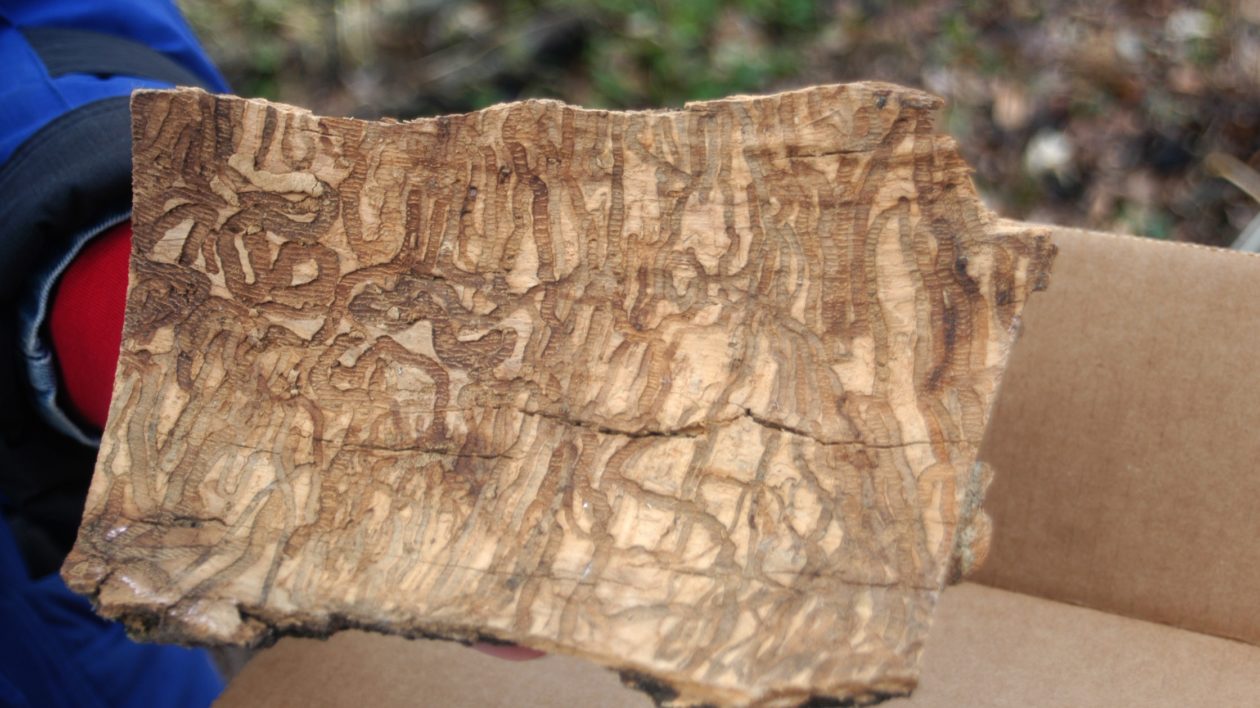
Flickr
Restoration in the Anthropocene
The river has been moving west gradually except in big floods when it jumps hundreds of feet. During these events it lays down high terraces of sediments, prime farmland because of the fertility and protection from normal spring freshets.
So the Conservancy focuses its restoration on these rare and rich habitats—the seven hayfields, which it will eventually turn over to the Fish and Wildlife Service.
They blazed with blooming forbs. Bees, hummingbirds and butterflies (tiger, black and spicebush swallowtails) nectared on the flowers. Monarchs, in slower flight, deposited eggs on milkweed.
Goldfinches, late breeders because they depend on thistle down for nests and thistle seeds for nutrition, sailed and dipped, shouting “perchickory.” One hunkered in a nest atop a planted sycamore.
In the distance stood a riverside phalanx of ash, pin oak, red maple, silver maple and eastern cottonwood. The lower floodplain is too wet to farm so it takes care of itself.
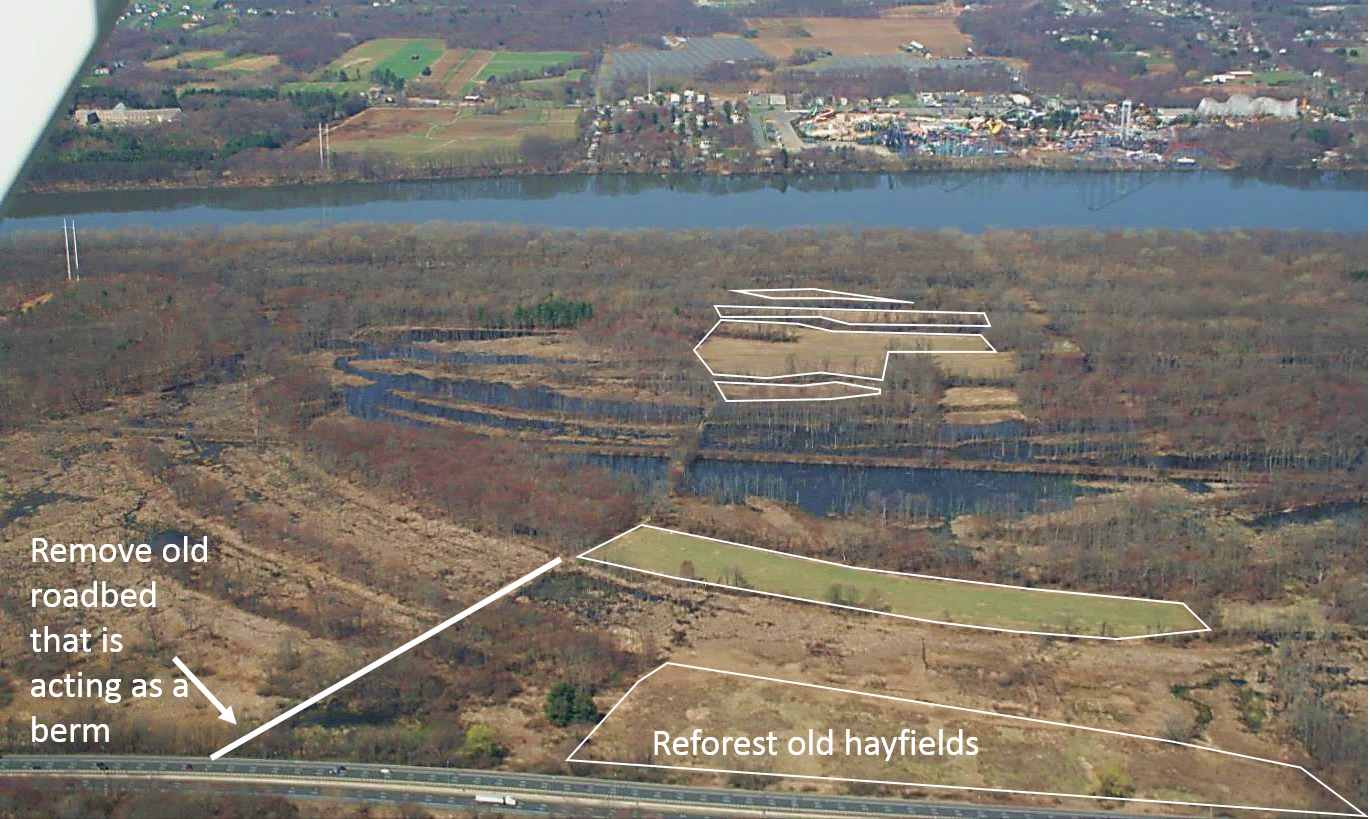
In the hayfields Marks and his team had planted thousands of trees and shrubs including resistant elms. But most were hidden by pioneers like Joe Pye weed and goldenrod. A decade hence the transition to high-terrace floodplain forest will be well underway.
Much of the hayfield acreage is protected by solar-powered electric fence. Without some form of deer control wildland restoration is now impossible in much of the East, a fact evidenced by the severely browsed seedlings planted outside the fences to provide comparative data. Managers get nowhere simply telling locals and officials that grossly overpopulated deer are nuking wildlife habitat. They need to show them.
An even bigger challenge is educating the public about the need for herbicides in wildland management. Without them the battle to save native ecosystems from invasive plants is lost.
Glyphosate, for example, is arguably the safest and most effective of all herbicides. So the Conservancy depends on it more than any of the other 18 herbicides it uses to save and restore wildlife habitat. At Fannie Stebbins it used glyphosate to clear non-native grasses from the hayfields so planted seedlings could get sun and surrounding trees could lay down native seed beds. Native wildflowers are also taking advantage of the openings.
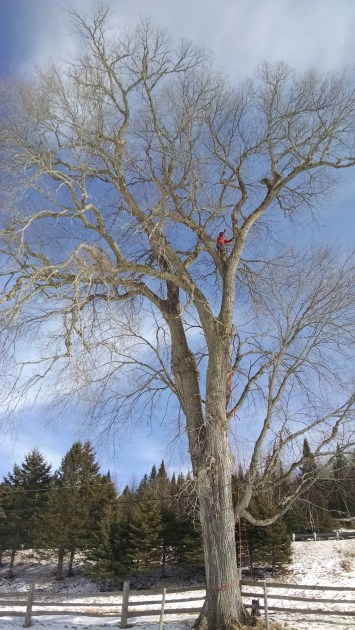
Yet a false claim, causing public panic, is circulating on social media that glyphosate is carcinogenic. Recently representatives of an environmental group knocked on Marks’ door, asking him to sign a petition to ban glyphosate on all public lands. “A ban would have blocked this restoration,” he told us.
As we hiked back to the road we kept hearing metallic grating from the far side of the river. At the cleared swath for the gas line bisecting the refuge—near the high-speed railroad line from Springfield to Hartford also bisecting the refuge—we spied the source of the racket: a roller coaster.
All three insults to nature reminded Donna and me about the vulnerability of wildland, especially floodplain forests, and the increasing need to protect and recover what we have left.
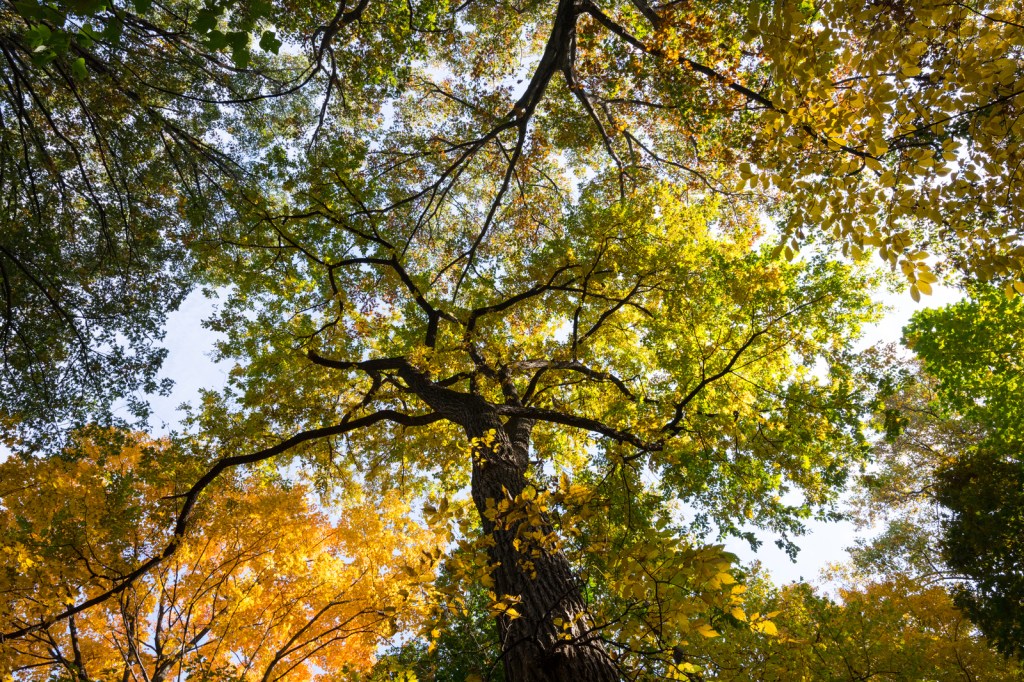



Thanks for the informative article. I did not know how glyphosate was used in a most positive healthy way. All of these lands you are restoring, I will be donating even more so you can continue your very valuable works. Very good. Thanks.
As a child growing up in The Hampton Roads area of Chesapeake Bay, I recall trees being removed because of Dutch Elm Disease. We lost three 25 foot willows as well, to what I am uncertain.
Perhaps, it is because of these tragedies, I found a deep abiding love of trees. Now living in the great Penn’s Woods ( as it were ) with its own tree problem. Hemlock?
Thank you, for your hard work and dedication!
As a child growing up in The Hampton Roads area of Chesapeake Bay, I recall trees being removed because of Dutch Elm Disease. We lost three 25 foot willows as well, to what I am uncertain.
Perhaps, it is because of these tragedies, I found a deep abiding love of trees. Now living in the great Penn’s Woods ( as it were ) with its own tree problem. Hemlock?
Thank you, for your hard work and dedication!
We have a giant elm tree in our yard – plus a couple “baby” elms. Are you still looking for elms? I have marveled for years that our trees seem healthy and suspect that they may be disease resistant as well.
I am appalled that you use glyphosate. I think it should be outlawed.
A wonderful and inspiring story somewhat marred by the author’s strangely aggressive defense of glyphosate/Roundup. Alas, like so many in the media, he has been fooled by Monsanto’s well-oiled propaganda machine.
I use Roundup on invasive species (particularly Alianthus here in Virginia) — but I use it reluctantly, since cutting/pulling/natural products don’t work as well. It is most definitely NOT safe, but is a necessary evil to give native ecosystems a chance to recover.
By parroting Monsanto’s PR flaks (especially here in the comments), the author betrays his ignorance. I encourage him and other industry apologists to actually read the WHO/IARC meta-review, which contains a discussion of hundreds of studies (300+) showing the significantly increased cancer risk (particularly in non-Hodgkin lymphoma and multiple myeloma) due to glyphosate exposure. There are also hundreds of in vitro studies and animal model experiments showing strong deleterious effects of glyphosate. The authors, by the way, are leading cancer and toxicology experts — not exactly anti-science hippies.
The review concluded that glyphosate is a Category 2A “probable carcinogen” (their second-highest level of evidence), which puts it in the same league as human papillomavirus type 68, lead, anabolic steroids, working in a petroleum refining plant, and the dry cleaning fluid tetrachloroethylene.
So, sure, you can make the case that the use of carcinogenic pesticides is an acceptable trade-off given the benefit to native species, but why be such a Monsanto cheerleader, Mr. Williams? A bizarre stance…. one hopefully not endorsed by The Nature Conservancy.
good article
Glyphosate is Most Definitely a Carcinogen as are All of the Glycerated Phosphate Herbicides!
However, using it to Clear Areas for Restoration is a Completely Acceptable Usage!
Glyphosate actually Beaks Down Quite Quickly into Harmless Chemicals with Ground Contact and it’s Gone!
The Problem with RoundUp are the RoundUp Ready Agricultural Crops that have been Developed by Monsanto and the Extent of Their Use in Our Agribusiness Driven Food System!
It’s the Glyphosate which is Actually Incorporated into Our Food Chain that IS Carcinogenic!
Hi Robert: You’re mistaken about glyphosate being “most definitely a carcinogen.” It most definitely is not for reasons I’ve already stated. But thanks for making the important point that its use for wildland restoration “is a Completely Acceptable Usage.”
Please give us some information about why you think glysophate is safe; that is not a common belief among people who care about such things, though Monsanto says it is (and we all know how trustworthy they are).
Crystal: When glyphosate is used according the label it safe because scientists say so, not because Monsanto says so.
Frankie and Karen: You’ve been misinformed about glyphosate. It is not a “harmful chemical” when applied according to the label.
Glyphosate (there are dozens of formulations, but Roundup is the one being targeted on social media) is arguably the safest of all herbicides and by far the most important tool we have for saving fish and wildlife whose habitat is being destroyed by invasive plants. “LD50” stands for the lethal dose that kills half the test animals per unit of mass. Higher is safer. For rats caffeine’s LD50 is 192 mg/kg, glyphosate’s 5,600. Glyphosate is a plant poison; it passes through mammalian digestive tracts.
The safety of herbicides is determined by scientists, not lawyers or California juries. Every scientific body in the world that has studied glyphosate has repeatedly reported that there’s NO link to cancer.
The International Agency for Research on Cancer (IARC) — a semi-autonomous branch of the World Health Organization — did not study glyphosate. It did a cursory review of six studies, cherry picking information. It then placed glyphosate on its “2A List” of substances with “limited or inadequate evidence of carcinogenicity” or, in IARC’s abbreviated translation, “probably carcinogenic.” Right up there with glyphosate on IARC’s long 2A List is “red meat.” This is the entire essence of glyphosate’s bad rep and all the current lawsuits against Monsanto. (The World Health Organization, by the way, disagrees with its IARC branch about glyphosate.)
Because glyphosate is super safe and super effective it has been overused in agriculture. But wildland managers use minuscule amounts, often painting in onto cut stumps. Glyphosate is often the best way and sometimes the only way to control invasive plants. Without it and other herbicides the battle to save native ecosystems is lost.
IARC’s opinion convinced California to require that all glyphosate products carry a cancer warning. But on February 26, 2018 a federal judge struck down the requirement, ruling it “inherently misleading . . . when apparently all other regulatory and governmental bodies have found the opposite.”
I would love to hear more about how the disease resistant elms are harvested and propagated!
More details here: https://blog.nature.org/2017/08/09/quest-restore-american-elms-nearing-finish-line/
Thank you so much to the people who are restoring this beautiful floodplain ecosystem.
I’ve been doing ecological restoration work in the Upper Midwest for more than thirty years, and have been lucky enough to learn from some of the best experts in my area. And we all use glyphosate. The alternative is to watch as rare natural areas become severely degraded and finally disappear. We know that because on a lot of land, that has already happened, especially to globally-endangered tallgrass prairie remnants.
I have read anti-glyphosate comments elsewhere on the Internet, advocating a total ban. It is apparent that many people who have written the comments that I have read not only haven’t done any restoration work, but have no idea what a total ban on glyphosate would mean for natural areas on this continent. It would be nice if people educated themselves more before making glyphosate comments, so they would have some idea of what the tradeoffs would be.
If we as a society were going to try to reduce overall glyphosate use, the logical place to start would be where the majority of it is used, which is on farms and urban landscaping. But of course those uses are controlled by powerful interest groups with big political clout. It is much easier to put pressure on public land managers and people who are working on natural areas. In many areas, including my state, those folks, and natural area advocates especially, have no clout whatsoever.
Like others across the country, I spend a lot of time and much of my life to try to restore the natural areas in my local landscape. Glyphosate is essential to that work. As climate change and other human forces increase, ecological restoration is getting harder. It is depressing to know that some people who know so little about ecological restoration want to make doing it far more difficult.
To those who support restoration, and to those who are doing it on the Conte National Wildlife Refuge, thank you again.
A wonderful restoration, TNC! Many thanks on behalf of all the wildlife that will benefit.
This is a crushing loss for our community. Why were we not consulted? We should have been able to vote before Longmeadow allowed you people to ruin our park!
I grew up going to this park, and I visit every November to say hi to our family dogs buried just past the old road. Such a shame TNC probably threw them away. Entirely avoidable. Sad.
I’m disappointed in TNC’s use of harmful chemicals in its work. Why do I donate if you’re just going to spray. Also not very ‘green’ of you to drive a truck. For what? You don’t need it to get to this property or to write! Beginning to think Monsanto and Dow chemical have you by the hook! This is my hometown! Disappointed in the TNC staff in Massachusetts for allowing this to happen!